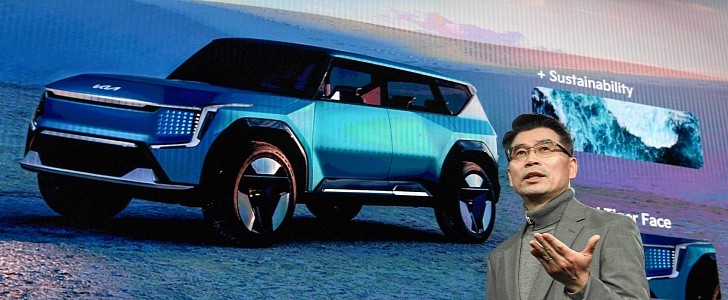After Hyundai released its plans to present 17 EV models and to sell 1.87 million electric cars by 2030, we said Kia would have at least ten new electric offerings as well. We were conservative: the Korean brand confirmed it will have 14 new EV models by 2030. Kia expects them to sell 1.2 million units per year by the end of the decade.
Curiously, Kia did not mention the IMA (Integrated Modular Architecture) even once in its report about these plans. If we had not learned about the E-GMP replacement at Hyundai’s presentation, we would guess that Kia would stick with the current platform to get there. That would make absolutely no sense.
First of all, because IMA’s primary mission is to make it cheaper to build a wide variety of electric cars just by changing the chassis, motors, and battery pack modules. If the entire group will shift to IMA, there’s no reason for Kia to keep it.
On top of that, IMA is an E-GMP evolution. Kia’s Plan S said it would produce 11 EVs, of which seven would be built with the previous platform. The EV1 is a vehicle that the E-GMP would not accommodate. In other words, adding it to the plan means that Kia will also use the IMA. The Korean carmaker may have skipped talking about it to give Hyundai priority in that.
Anyone familiar with Hyundai’s presentation will notice the familiarities with what Ho Sung Song said. The president and CEO of Kia Corporation also mentioned that the company would manufacture PBVs (purpose-built vehicles). The difference from Hyundai’s plans is that Kia intends to lead this market by 2030.
Kia has not been as generous as Hyundai in revealing what it intends to build. It talked about the EV1 going up to the EV9 large SUV that will be launched in 2023. That alone covers 9 of the 14 vehicles it intends to sell.
Two more will be electric pickup trucks. Kia states that they will be “a dedicated electric pickup truck and a strategic model for emerging markets.” If we were to translate that, we’d say that Kia will have a pickup truck with a body-on-frame structure for the North American market and also a unibody model for other places.
The missing three EVs to complete 14 models are a mystery. One of them could be the CV, a vehicle that Kia presented as a concept in 2019. It shares the E-GMP platform that the EV6 and the IONIQ 5 currently use and will make its world premiere on March 21. Sales will begin on July 21.
Unlike Hyundai, Kia also spoke about ICE and “eco-friendly” models, including hybrids and plug-in hybrids. By 2030, the Korean brand intends to sell 2 million units of these vehicles and 4 million cars in total. Excluding the 1.2 million EVs it plans to sell, Kia will have 800,000 ICE sales, a clear minority in this universe.
To ensure it can build this many EVs, Kia has made contracts to secure 119 GWh per year in batteries by 2030. Hyundai will have 170 GWh in cells by the same year, and it plans to start selling EVs with solid-state batteries by 2030 as well. Kia has apparently not released its plans for solid-state cells.
First of all, because IMA’s primary mission is to make it cheaper to build a wide variety of electric cars just by changing the chassis, motors, and battery pack modules. If the entire group will shift to IMA, there’s no reason for Kia to keep it.
On top of that, IMA is an E-GMP evolution. Kia’s Plan S said it would produce 11 EVs, of which seven would be built with the previous platform. The EV1 is a vehicle that the E-GMP would not accommodate. In other words, adding it to the plan means that Kia will also use the IMA. The Korean carmaker may have skipped talking about it to give Hyundai priority in that.
Anyone familiar with Hyundai’s presentation will notice the familiarities with what Ho Sung Song said. The president and CEO of Kia Corporation also mentioned that the company would manufacture PBVs (purpose-built vehicles). The difference from Hyundai’s plans is that Kia intends to lead this market by 2030.
Kia has not been as generous as Hyundai in revealing what it intends to build. It talked about the EV1 going up to the EV9 large SUV that will be launched in 2023. That alone covers 9 of the 14 vehicles it intends to sell.
Two more will be electric pickup trucks. Kia states that they will be “a dedicated electric pickup truck and a strategic model for emerging markets.” If we were to translate that, we’d say that Kia will have a pickup truck with a body-on-frame structure for the North American market and also a unibody model for other places.
The missing three EVs to complete 14 models are a mystery. One of them could be the CV, a vehicle that Kia presented as a concept in 2019. It shares the E-GMP platform that the EV6 and the IONIQ 5 currently use and will make its world premiere on March 21. Sales will begin on July 21.
Unlike Hyundai, Kia also spoke about ICE and “eco-friendly” models, including hybrids and plug-in hybrids. By 2030, the Korean brand intends to sell 2 million units of these vehicles and 4 million cars in total. Excluding the 1.2 million EVs it plans to sell, Kia will have 800,000 ICE sales, a clear minority in this universe.
To ensure it can build this many EVs, Kia has made contracts to secure 119 GWh per year in batteries by 2030. Hyundai will have 170 GWh in cells by the same year, and it plans to start selling EVs with solid-state batteries by 2030 as well. Kia has apparently not released its plans for solid-state cells.







